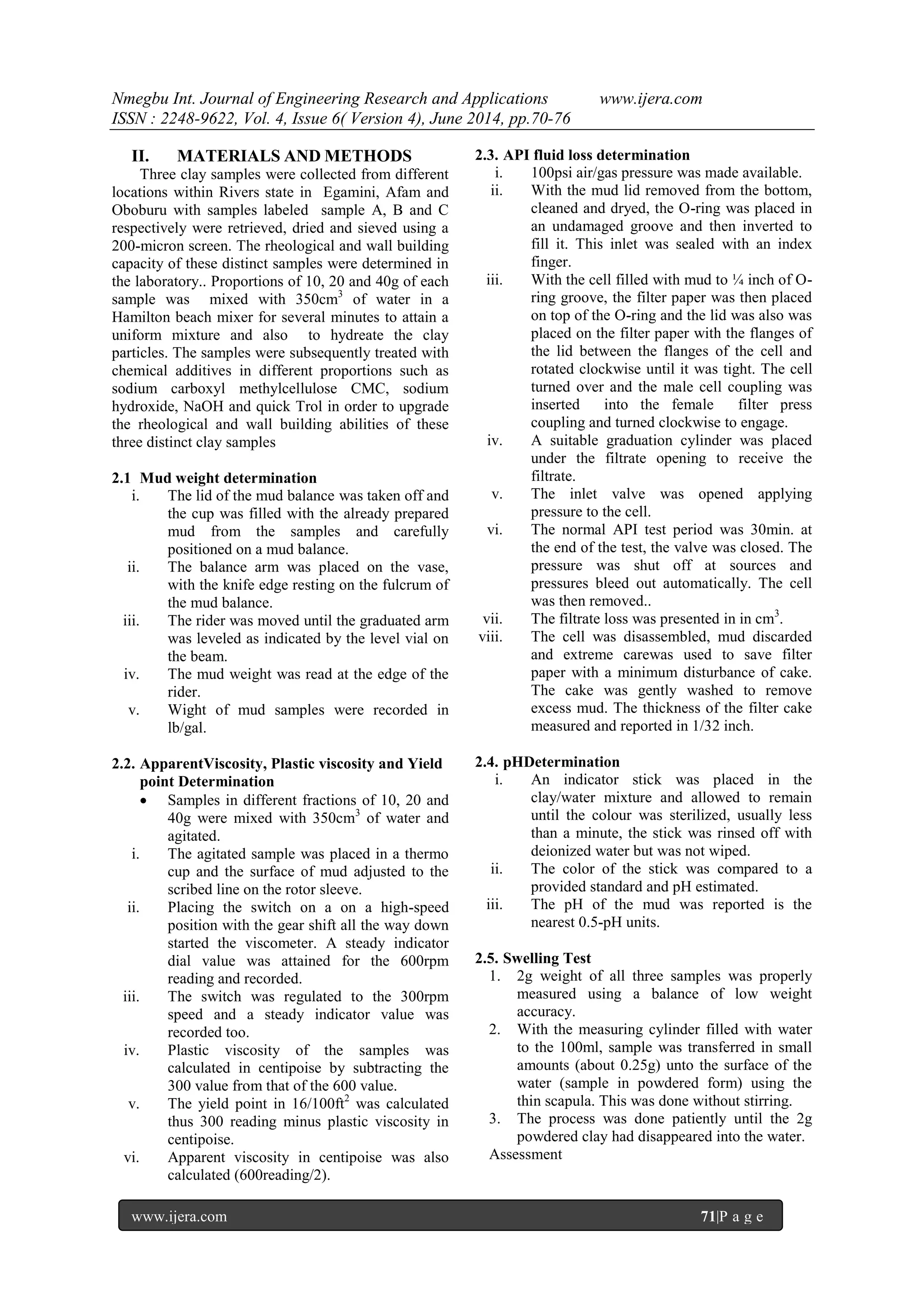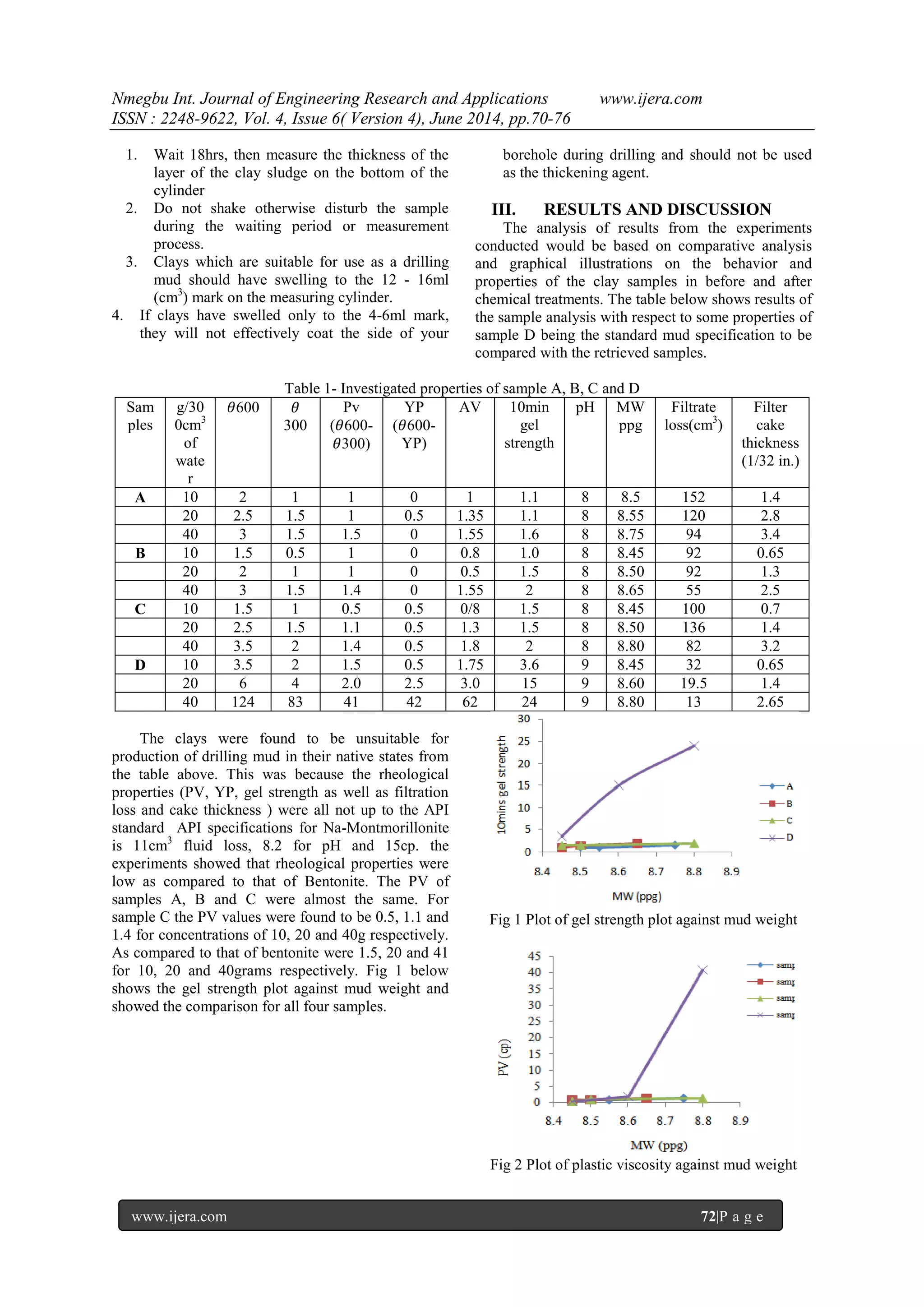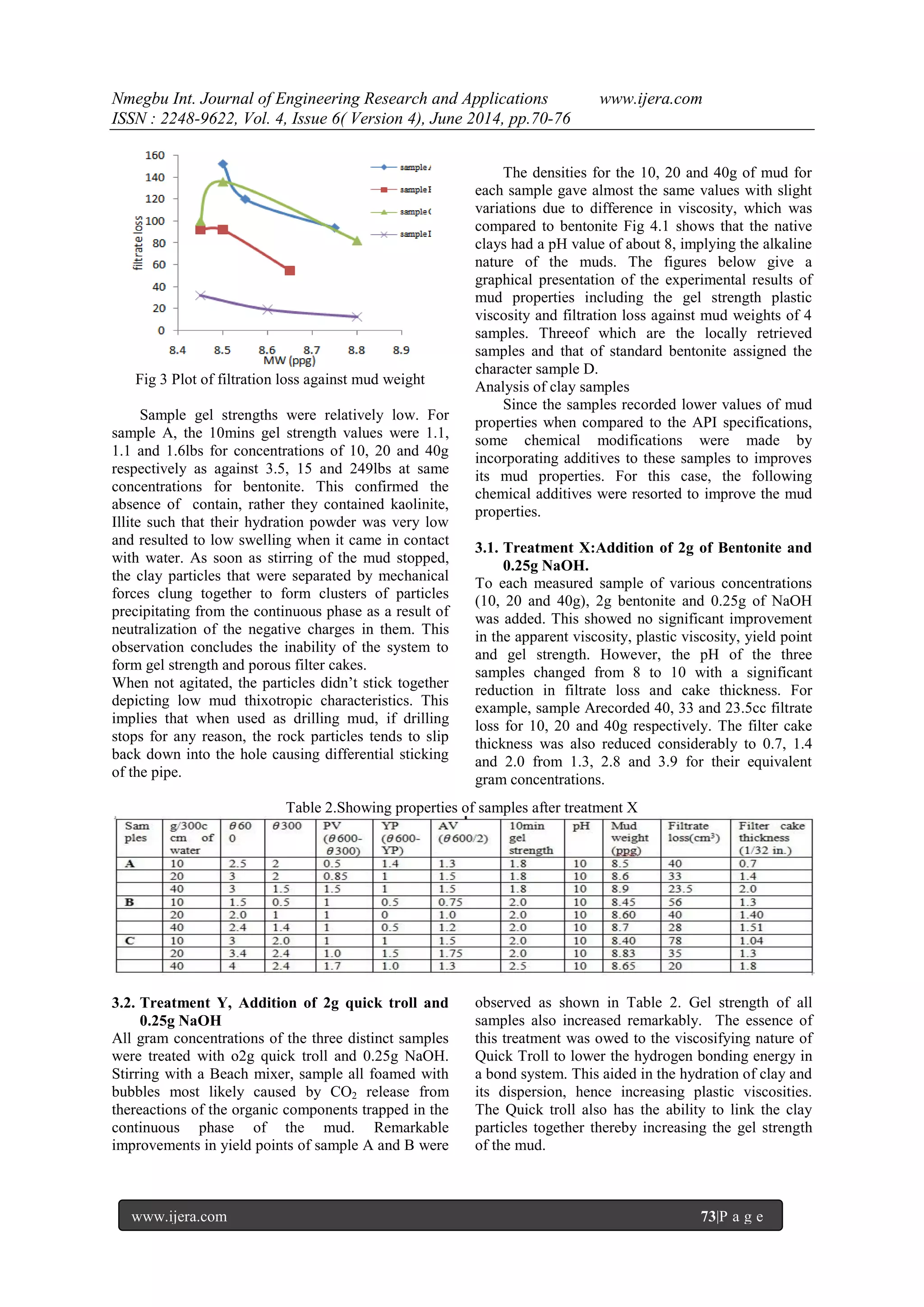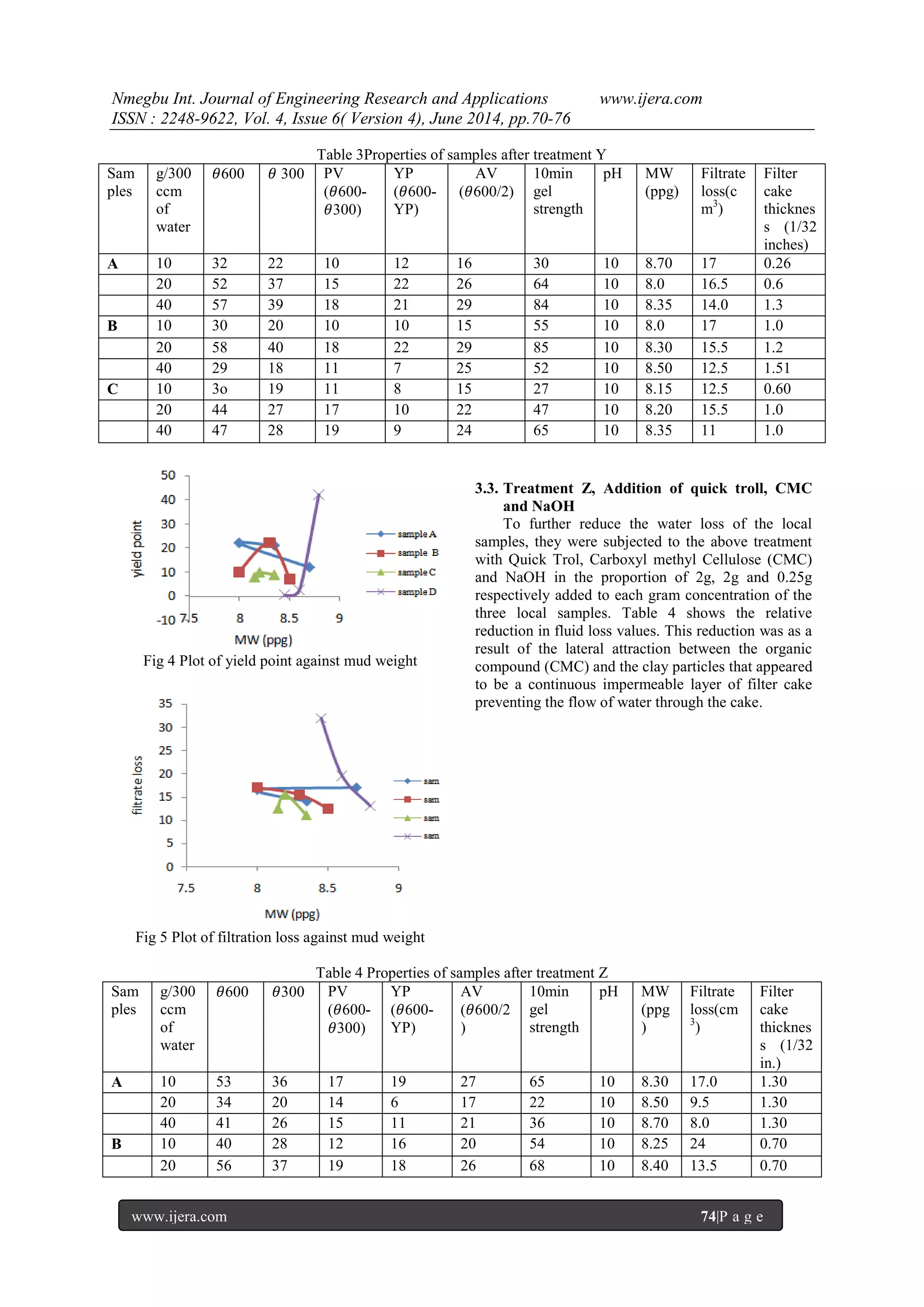This document summarizes a laboratory investigation of clay samples from Rivers State, Nigeria for use in drilling mud preparation. Three clay samples were collected from different locations and tested for rheological and wall building properties. The results showed the native clay samples were unsuitable for drilling mud compared to standard bentonite. The clay samples were then treated with additives like bentonite, NaOH, and quick trol. This improved some properties like pH, viscosity and gel strength but filtration loss and cake thickness still did not meet API standards. Further testing is needed to determine if the treated clay samples could be suitable for drilling mud with additional refinements.
![Nmegbu Int. Journal of Engineering Research and Applications www.ijera.com
ISSN : 2248-9622, Vol. 4, Issue 6( Version 4), June 2014, pp.70-76
www.ijera.com 70|P a g e
Laboratory Investigation of Rivers State Clay Samples for Drilling Mud Preparation Nmegbu, Chukwuma Godwin Jacob* *(Department of Petroleum Engineering,Rivers State University of Science and Technology, P.M.B 5080, Nigeria, ABSTRACT Drilling fluids are an integral part of any oil and gas industry, providing the ease to which wells are drilled to access subsurface reservoir fluids. Certain rheology and mineralogical properties of the clay material used for drilling mud preparation must be critically investigated since clay deposits in different location exhibits different characteristics. Clay samples were collected from three different geographical locations namely; Egbamini (Emolga), Afam Street (Port Harcourt) and Oboboru (onelga) local government areas in Rivers state. Their rheological and wall building properties were measured in the laboratory to determine their suitability for drilling mud formulation. Results showed that in their respective native states, they proved unsuitable for drilling mud preparation when compared to standard Bentonite because they were observed to show responses far below the required API standards for mud formulation.
Keywords:Clay, Drilling mud, properties, Salt Concentration
I. INTRODUCTION
The use of water to cool and lubricate drill bits during drilling in early drilling practices encountered quite a number of problems traceable to the inability of water to perform certain drilling mud functions. The introduction of mud for such problems in the industry became widespread between the late 80’s and early 90’s with the purpose of continuously removing drill cuttings from the hole. As rotary drilling advanced, more engineering attention was needed to critically analyze mud composition and efficiency for its performance [1]. The use of only water as drilling fluid was kicked against because of the tendency of formation damage as a result of hole instability. Early drillers encountered such problems and used muddy water to control a potentially catastrophic sand problem. [2],[3]. The investigation of the use of the mud-laden fluid as a mixture of water with any clay, which will remain suspended in water for a considerable length of time was conducted by Hegen et al. They concluded with the recommendation that a fine sticky clay described as “gumbo” was a good component for drilling mud. [4]. A good mud besides been able to suspend clay materials in water for a long time should be free of sand cuttings and similar materials of specific gravity within the range of 1.05 – 1.15 ( density 8.77ppg – 9.58pppg. [4], [5]. The introduction of weighting the mud using additives and fine grains from oxide was recommended for weighting in water slurries, given a mud weight in the range of 15 – 18 ppg. The use of these materials was short lived due to its dark color and skin straining effects. Further
research on this methodology led to the advancement of barium sulphate (barite) for mud weighting due to its high specific gravity, low abrasive properties and toxicity level. The discovery of Bentonite for mud preparation was later introduced to the industry, with subsequent tests showing its ability not only to suspend heavy cuttings but having comparatively good mud properties such as moderate filtration loss and good wall building properties, viscosity and gel strength . [6], [7] This study tends to analyze both the rheological properties and mineralogy of three clay samples retrieved from various locations in Rivers state, Nigeria. These three samples will be subjected to certain laboratory experiments to confirm or ascertain their suitability for drilling mud formulation and results of their properties will be compared to Wyoming bentonite which is a standard for mud preparation. Clays are the most abundant class of sedimentary rocks, making up to 40% of mineral contents in these sedimentary rocks. These relatively cheap sources off colloidal materials with an average particle size of about 2microns have the ability to exhibit the plasticity phenomenon [8]. The alternating sheets of silica and alumina with slightly different arrangements that make up the unit layers of each clay material. The geographic location, chemical and colloidal nature of the retrieved clay is also a contributory factor in determining certain properties such as its swelling capacities. Montmorilonites, illites. Kaolinites, attapulgites and sepiolites are common clay classifications with montmorilonite being the most suitable class for drilling mud preparation [9], [10].
RESEARCH ARTICLE OPEN ACCESS](https://image.slidesharecdn.com/m046047076-140904034206-phpapp02/75/M046047076-1-2048.jpg)




![Nmegbu Int. Journal of Engineering Research and Applications www.ijera.com
ISSN : 2248-9622, Vol. 4, Issue 6( Version 4), June 2014, pp.70-76
www.ijera.com 75|P a g e
40
33
21
12
9
16.5
34
10
8.85
8.5
1.20
C
10
88
26
12
14
17
33
10
8.30
24
1.05
20
51
33
18
15
25
57
10
8.40
11.5
1.05
40
71
50
21
29
34
90
10
8.60
7.5
1.20
Fig 6 Plot plastic viscosity against mud weight
Fig 7. Plot of YP against mud weight
Fig 8. Plot of yield point against mud weight
Fig 9. Plot of gel strength against mud weight
3.4. Swelling test analysis
All three samples did not meet the swelling test criteria of 12 – 16ml mark on the cylinder. Sample C recorded the highest swelling attaining the 5ml mark. Samples A and B recorded 4ml and 3ml respectively on the measuring cylinder.
IV. CONCLUSION
This investigation was prompted by the inherent oil and gas activities within the geographical area, so as to maximize its clays rather than importation of clay material by drilling companies. However, from the figures and graphical representation of samples analysed, it is evident that these clays fromEgbamini (Emolga), AfamStreet(Mile 1 PH) andOboboru(Onelga) local government areas in Rivers state proved to be poor potential drilling mud materials far below the API standards for drilling mud formulation. ACKNOWLEDGEMENT The author is grateful to WoduEbimobowei Kevin for his immense contributions in this work. References
[1] J. M. Davis, The Effect of the Use of Oil Base Drilling Muds on the Environment, J. of Pet. Tech., 38(15), July 1984, 30 – 41.
[2] J. O. Lewis. and W. F . McMurray, The Use of Mud Laden Fluids in Oil and Gas Wells, US Bureau of Mine material Test, 1977, 134.
[3] J. A. Clark. And M. T Halbouty, SpindleTop, Cult Public Co., Houston, 1980.
[4] A. G Hegen. and J. A. Poland, Drilling Wells in Oklahoma by Mud Laden Fluid Method, US Bureau of Mine Material Testing, 1967, pp.68.
[5] F. I Okoro,Suitability of Ihube clays for Preparing Drilling Fluid, B.Eng. Thesis, Dept of Pet Eng., Univ. of Port Harcourt, 1994.
[6] B. K. Stroud,Use of Barites as a Mud Laden Fluid, A Publication of World Oil Journal, June 1925, 29.
[7] T.B. Wayne, The Use of Bentonite as a Mud Laden Fluid, A Publication of World Oil journal, Jan. 1930, 98.
[8] J. E. Taylor. And M.A. Mayor, Invert Oil Mud Rheology as a Function of Temperature and Pressure, SPE/ADC 13458, Mar 1985.
[9] G.V. Chilingarian and G., Murkhejee, Drilling and Drilling Fluids. (New York,](https://image.slidesharecdn.com/m046047076-140904034206-phpapp02/75/M046047076-6-2048.jpg)
![Nmegbu Int. Journal of Engineering Research and Applications www.ijera.com
ISSN : 2248-9622, Vol. 4, Issue 6( Version 4), June 2014, pp.70-76
www.ijera.com 76|P a g e
USA: Elsevier Scientific Publishing Company,1981).
[10] A.C.H. Darley and G.R. Gray, Composition and Properties of Drilling and Completion Fluids.(Houston, USA:Gulf Public Co., 5th Ed., 1988).
[11] M Amanullah and L. Yu, Environmentally Friendly Fluid Loss Additives to Protect the Marine Environment from the Detrimental Effect of Mud Additives,Journal of Petroleum Science Engineering, 48, 2005, 199-208. [12] American Petroleum Institute (API), Recommended Practice for Field Testing Water Based Drilling Fluid, 13A, 1993, 7- 28.](https://image.slidesharecdn.com/m046047076-140904034206-phpapp02/75/M046047076-7-2048.jpg)